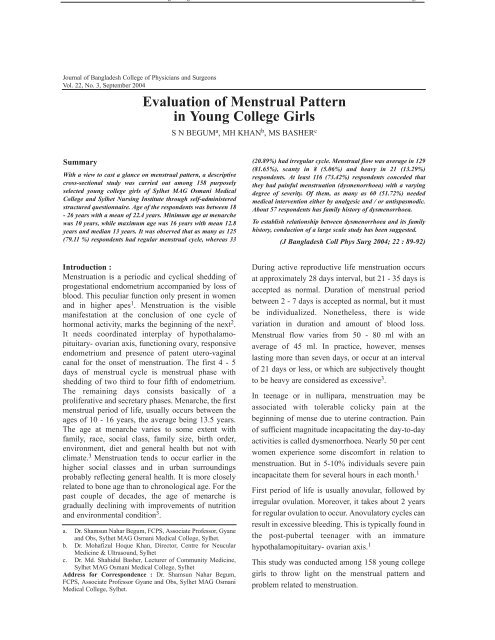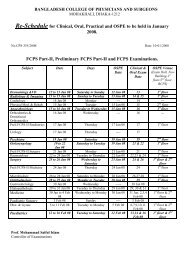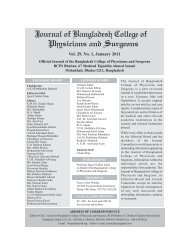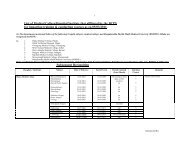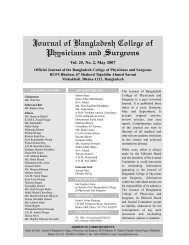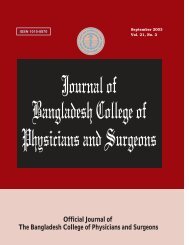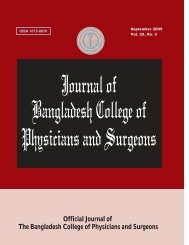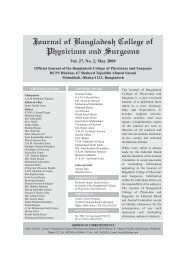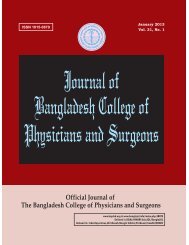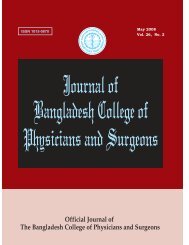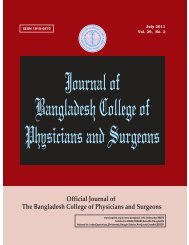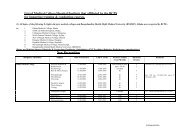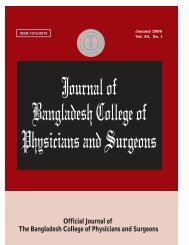September 2004 - bcps
September 2004 - bcps
September 2004 - bcps
Create successful ePaper yourself
Turn your PDF publications into a flip-book with our unique Google optimized e-Paper software.
Journal of Bangladesh College of Physicians and SurgeonsVol. 22, No. 3, <strong>September</strong> <strong>2004</strong>Evaluation of Menstrual Patternin Young College GirlsS N BEGUM a , MH KHAN b , MS BASHER cSummaryWith a view to cast a glance on menstrual pattern, a descriptivecross-sectional study was carried out among 158 purposelyselected young college girls of Sylhet MAG Osmani MedicalCollege and Sylhet Nursing Institute through self-administeredstructured questionnaire. Age of the respondents was between 18- 26 years with a mean of 22.4 years. Minimum age at menarchewas 10 years, while maximum age was 16 years with mean 12.8years and median 13 years. It was observed that as many as 125(79.11 %) respondents had regular menstrual cycle, whereas 33(20.89%) had irregular cycle. Menstrual flow was average in 129(81.65%), scanty in 8 (5.06%) and heavy in 21 (13.29%)respondents. At least 116 (73.42%) respondents conceded thatthey had painful menstruation (dysmenorrhoea) with a varyingdegree of severity. Of them, as many as 60 (51.72%) neededmedical intervention either by analgesic and / or antispasmodic.About 57 respondents has family history of dysmenorrhoea.To establish relationship between dysmenorrhoea and its familyhistory, conduction of a large scale study has been suggested.(J Bangladesh Coll Phys Surg <strong>2004</strong>; 22 : 89-92)Introduction :Menstruation is a periodic and cyclical shedding ofprogestational endometrium accompanied by loss ofblood. This peculiar function only present in womenand in higher apes 1 . Menstruation is the visiblemanifestation at the conclusion of one cycle ofhormonal activity, marks the beginning of the next 2 .It needs coordinated interplay of hypothalamopituitary-ovarian axis, functioning ovary, responsiveendometrium and presence of patent utero-vaginalcanal for the onset of menstruation. The first 4 - 5days of menstrual cycle is menstrual phase withshedding of two third to four fifth of endometrium.The remaining days consists basically of aproliferative and secretary phases. Menarche, the firstmenstrual period of life, usually occurs between theages of 10 - 16 years, the average being 13.5 years.The age at menarche varies to some extent withfamily, race, social class, family size, birth order,environment, diet and general health but not withclimate. 3 Menstruation tends to occur earlier in thehigher social classes and in urban surroundingsprobably reflecting general health. It is more closelyrelated to bone age than to chronological age. For thepast couple of decades, the age of menarche isgradually declining with improvements of nutritionand environmental condition 3 .a. Dr. Shamsun Nahar Begum, FCPS, Associate Professor, Gyaneand Obs, Sylhet MAG Osmani Medical College, Sylhet.b. Dr. Mohafizul Hoque Khan, Director, Centre for NeucularMedicine & Ultrasound, Sylhetc. Dr. Md. Shahidul Basher, Lecturer of Community Medicine,Sylhet MAG Osmani Medical College, SylhetAddress for Correspondence : Dr. Shamsun Nahar Begum,FCPS, Associate Professor Gyane and Obs, Sylhet MAG OsmaniMedical College, Sylhet.During active reproductive life menstruation occursat approximately 28 days interval, but 21 - 35 days isaccepted as normal. Duration of menstrual periodbetween 2 - 7 days is accepted as normal, but it mustbe individualized. Nonetheless, there is widevariation in duration and amount of blood loss.Menstrual flow varies from 50 - 80 ml with anaverage of 45 ml. In practice, however, menseslasting more than seven days, or occur at an intervalof 21 days or less, or which are subjectively thoughtto be heavy are considered as excessive 3 .In teenage or in nullipara, menstruation may beassociated with tolerable colicky pain at thebeginning of mense due to uterine contraction. Painof sufficient magnitude incapacitating the day-to-dayactivities is called dysmenorrhoea. Nearly 50 per centwomen experience some discomfort in relation tomenstruation. But in 5-10% individuals severe painincapacitate them for several hours in each month. 1First period of life is usually anovular, followed byirregular ovulation. Moreover, it takes about 2 yearsfor regular ovulation to occur. Anovulatory cycles canresult in excessive bleeding. This is typically found inthe post-pubertal teenager with an immaturehypothalamopituitary- ovarian axis. 1This study was conducted among 158 young collegegirls to throw light on the menstrual pattern andproblem related to menstruation.


